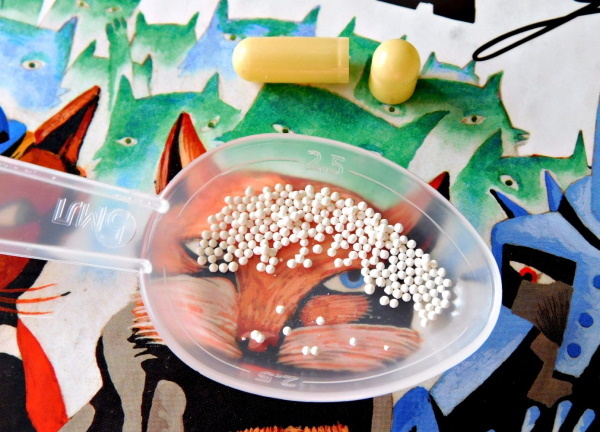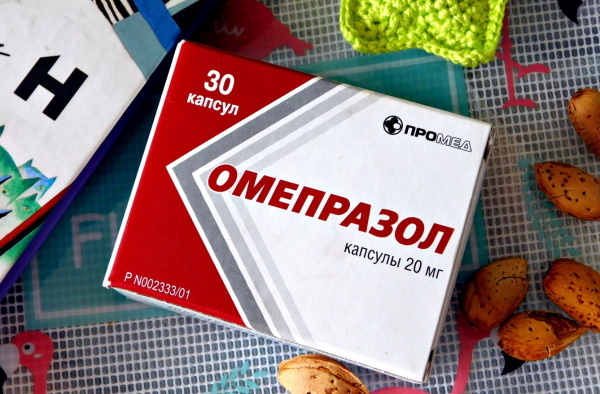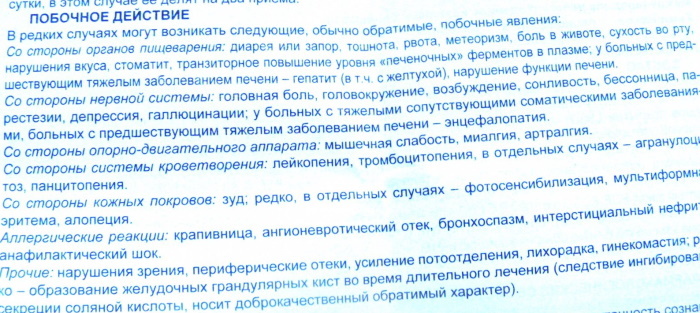Content
- Omeprazole release form
- Composition of the preparation
- Pharmacological properties
- Pharmacodynamics and pharmacokinetics
- Indications for use
- Contraindications
- At what age can the drug be used?
- Instructions for use, dosage for pancreatitis
- Side effects
- Overdose
- special instructions
- Drug interactions
- Analogs
- Terms, conditions of sale and storage
- Price
- Video about the drug Omeprazole
Omeprazole is often used with pancreatitis, despite the fact that its action is not directed directly to the therapy of the pancreas. The tool is intended to eliminate the symptoms of diseases of the digestive tract, but in case of inflammation of the gland, it can be used as directed by a specialist. The drug facilitates the course of the disease and reduces the risk of complications from other organs.
Omeprazole release form
The drug is sold in the form of oral capsules. They have a standard shape and size, packaged in ordinary plates with a foil side of 10 pieces. The cardboard box contains a plate with capsules and a description. In this description, all the nuances of the application, possible complications during therapy, contraindications are indicated in detail.
In pharmacies, the drug is also sold in the form of a lyophilisate for the preparation of a solution, which is administered parenterally. It is a white or almost white mass placed in a small glass bottle. This bottle is in an individual cardboard box, a description is attached to it.
Composition of the preparation
The medication contains the substance omeprazole, which provides the main therapeutic effect on the body.
In the composition of the capsules, auxiliary ingredients can be distinguished:
- Gelatin.
- Sucrose.
- Hypromellose.
- Cetyl alcohol.
- Sodium hydrogen phosphate.
These substances have no therapeutic properties. 1 capsule contains 20 mg of the active substance, and 1 vial of lyophilisate contains 40 mg of the active ingredient, as well as disodium edetate and sodium hydroxide.
Pharmacological properties
Omeprazole for pancreatitis of the pancreas is used due to a positive effect on the organs of the digestive tract. The drug belongs to the group of proton pump inhibitors. Its principle of action is based on the ability of the active ingredient to suppress the production of hydrochloric acid.
As a result, the discomfort associated with the negative effect of acid on the walls of the stomach is eliminated. With pancreatitis, the patient's condition worsens against the background of aggravation of the symptoms of gastritis or peptic ulcer disease.
That is why the medicine is used as part of the complex treatment of different stages of pancreatitis, even in the presence of complications from other organs of the digestive system.
Pharmacodynamics and pharmacokinetics
After the penetration of the agent inside, its components are distributed throughout the body. Omeprazole quickly reduces the amount of hydrochloric acid produced, which leads to an improvement in the condition. Against the background of a decrease in the level of hydrochloric acid, a normalization of the enzyme composition is observed.
It is this action that is most important for patients suffering from various forms of pancreatitis. Improving enzyme production helps facilitate digestion and also reduces stress on the pancreas.
The drug also has other properties:
- Helps prevent the development of persistent constipation, which often bothers patients with damage to the digestive system. As a result, the elimination of accompanying deviations is noted, the work of the intestines is facilitated.
- Stimulates the production of the necessary digestive enzymes to ensure the correct distribution of food components.
- Facilitates the work of the liver and gallbladder.
- Promotes the healing of erosive foci that appear on the walls of the stomach and intestines with intense production of hydrochloric acid.
- It somewhat reduces the pressure inside the pancreas by reducing the production of digestive juices.
As a result of taking the medicine, there is an improvement in the condition of not only the stomach and intestines, but also other parts of the digestive system.
When taken orally, the capsule quickly dissolves in the digestive tract, the substance is absorbed through the walls of the small intestine and is distributed throughout the body. The maximum concentration of the substance is detected after 30-60 minutes, which depends on the characteristics of the patient's body and the rate of absorption of the main substance.
With parenteral administration, the concentration in the blood reaches its maximum level a little earlier, but this depends on the administered dosage. The therapeutic effect occurs within 30-40 minutes after taking a single dosage. The processing of the active substance takes place in the liver, after which the decay products are excreted with the help of the kidneys.
Disruption of the liver and kidneys leads to a disruption in the processing and removal of ingredients from the body, but the effectiveness of therapy does not decrease.
Indications for use
Omeprazole is not always used for pancreatitis or other diseases of the pancreas.
The main indications for the use of the drug:
- Peptic ulcer of the stomach and duodenum, accompanied by severe organ disorders and the appearance of complications.
- Acute and chronic pancreatitis. The drug can be used with or without complications. Usually it is included in the course of the main treatment.
- Gastritis with increased acidity of gastric juice. Patients in the acute stage have severe symptoms that impair the functioning of the entire digestive system.
- Liver pathologies, accompanied by complications from the stomach and intestines.
- Diseases of the mucous membrane of the digestive tract, in which there is a threat of perforation of the organ wall.
- Dyspeptic disorders that appear against the background of pathologies of the digestive system and often worsen the condition of patients.
The drug can be prescribed as the main method of therapy or as an auxiliary method in the presence of concomitant abnormalities in an acute form.
Contraindications
The drug is not prescribed in case of intolerance to the components of the composition or a tendency to such disorders in the patient's history.
There are other obstacles to therapy with different dosage forms of the drug:
- The period of bearing a child at different times and lactation. The remedy at this time can provoke complications, despite the absence of a teratogenic effect on the development of the child.
- Lack of liver and kidney function in severe form. With a mild course of the disease, the drug does not provoke negative reactions, but its severe form is considered a contraindication for the appointment.
- Internal bleeding. The drug can aggravate the symptoms, therefore it is not used for such disorders.
- Intestinal obstruction of various origins.
The drug is allowed to be used during the rehabilitation period after undergoing surgery on the organs of the digestive tract. But capsules are not used in this case. For elderly patients, the medication is prescribed with caution and after a preliminary examination.
At what age can the drug be used?
Omeprazole with pancreatitis of the pancreas and other disorders is allowed to be used only in the therapy of patients over 5 years old. It is important to take into account the patient's weight, which should not be less than 20 kg. For patients weighing less than 20 kg, the drug is not prescribed, even if they are more than 5 years old.
Instructions for use, dosage for pancreatitis
Depending on the course of the pathological condition, the dosage of the drug may differ. It is also determined taking into account the patient's age. Children rarely suffer from pancreatitis, but when such a violation is detected, they are prescribed no more than 20 mg per day, that is, 1 capsule. Lyophilisate is not used in most cases.


When taking capsules, it is important to drink plenty of water. Typically, the standard regimen assumes consumption 30 minutes before a meal, which facilitates processing and reduces the risk of complications.
Adults, when diagnosing pancreatitis, take 40 mg of the drug per day, that is, 2 capsules. The severe course of the disorder requires parenteral administration of the medication. For this, the contents of 1 bottle are dissolved in 20 ml of sodium chloride 0.9%. This method is used for intravenous jet infusion. The drug can be infused using a dropper. In this case, 1 bottle contains 100 or 200 ml of sodium chloride.
The duration of therapy with the drug is 2-4 weeks, depending on the severity of the manifestations. For each patient, a standard scheme cannot be applied, since it is determined at the time of diagnosis and may differ. In combination with other medications, the drug is often used for a long time, but the decision to prolong the treatment is made only by the doctor.
Treatment of children often lasts no more than 2 weeks, since in most cases they do not suffer from severe forms of the disease.
Side effects
Medication in various forms often provokes negative reactions, even if all the rules are followed. Violation of the instructions significantly increases the risk of complications.
| Damage area | Frequent negative reactions |
| Nervous system | The nervous system does not suffer so often during therapy, but sometimes patients notice dizziness and headache, drowsiness and decreased performance. Prolonged use provokes a depressive state or strong emotional arousal. In different patients, negative reactions and their severity may differ. After discontinuation of treatment, manifestations may disappear, sometimes medication is required to normalize the condition. |
| Digestive organs | Disorders of the digestive tract are frequent. They can manifest themselves in different symptoms, which depend on the duration of use and the characteristics of the organism of a particular patient. Patients may experience diarrhea or persistent constipation, pain in the stomach and intestines, heartburn, nausea, and bouts of vomiting. With prolonged preservation of manifestations, the condition worsens, there is no appetite, but there is a strong thirst, signs of dehydration. |
| Skin, mucous membranes | During therapy, the skin suffers if allergies develop. However, it affects not only the skin of the body, but also the scalp. Loss of stripes is observed, up to the development of alopecia. Allergy is manifested by classic symptoms in the form of rash, itching, irritation. In some cases, symptoms affect the mucous membranes of the eyes, nose and mouth. |
| Musculoskeletal system | Pain in muscles, articular joints disturb patients with long-term therapy. Sometimes convulsions are observed, which aggravate the general condition, disrupt the patient's mobility. |
| Blood system | When using the drug, a violation of the process of formation of blood cells or their intensive formation is noted. In each of these cases, the patient's condition worsens, but changes can be seen in laboratory blood tests. |
Patients may experience disorders of the genitourinary system, accompanied by a decrease in libido, inflammatory processes of the bladder, pain in the mammary glands. Atypical disorders can manifest themselves in the form of increased sweating of the hands and feet, increased salivation.
Overdose
Omeprazole is often used for pancreatitis of the pancreas, since it provokes an overdose only in some cases. Despite this, doctors do not exclude the possibility of such complications.
Overdose is accompanied by fluctuations in blood pressure indicators, tachycardia and heart rhythm disturbances. Symptoms do not go away without specific treatment. In severe cases, the patient requires a hemodialysis procedure. The remedy does not have a specific antidote, therefore, the treatment is symptomatic, depending on the severity of certain manifestations.
If negative reactions or signs of an overdose appear, it is forbidden to use medications on your own or ignore the symptoms. It is worth contacting a specialist immediately.
special instructions
Treatment with the drug in the form of capsules in most cases is carried out on an outpatient basis. This is considered to be the main advantage of this dosage form. If the patient is diagnosed with severe pancreatitis and associated abnormalities, parenteral administration of the medication is prescribed.
Infusion of medication with a dropper is carried out in a hospital. The doctor constantly monitors the patient's condition, and when it worsens, he prescribes other means. During the treatment period, it is important to monitor the body's response to the drug. Sometimes the application is canceled if the desired result is achieved.
The doctor independently prohibits adjusting the rate or prolonging the therapeutic course. This almost always leads to acute negative reactions.
Drug interactions
The drug is not prescribed concurrently with other drugs from the group of proton pump inhibitors. But it is often combined with enzymatic, pain relieving, antibacterial medicines.
It is allowed to use in combination with antacid and nootropic drugs, drugs, the action of which is aimed at the therapy of pathologies of the heart and blood vessels. If you need to use any means, you must first consult with a specialist.
Analogs
The drug has many analogues with similar composition and therapeutic properties. They can be used if it is not available in pharmacies or it is impossible to prescribe for various reasons.
The most effective substitutes:
- Omez is considered the most popular analogue, the price of which is slightly higher than that of the original. It also contains omeprazole as the main component, so the effect of the drug does not differ. The drug can be used as an auxiliary method for the treatment of pancreatitis at various stages, diseases of the stomach and intestines of inflammatory origin. The duration of therapy and dosage is determined by the doctor in each case individually. Unlike the original, the analog is available in the form of tablets and capsules, which allows each patient to choose a convenient shape. A lyophilisate is also produced to obtain a solution.
- Gastrozole has a similar composition and therapeutic properties, therefore it can be used as a substitute. It is produced only in the form of capsules for oral use. The drug suppresses the production of hydrochloric acid, helps to reduce its negative effect on the walls of the digestive tract. The absence of a lyophilisate makes it impossible to prescribe a substitute in the case when the patient, for various reasons, cannot take capsules. Despite this, the analogue is considered to be quite effective.
- Ultop also available in capsule form, contains omeprazole. Unlike the original, the dosage of the active ingredient in a capsule can be 10, 20 or 40 mg. This allows the patient to be prescribed the minimum dosage when necessary. The remedy is effective, often used for long courses if the patient suffers from a chronic form of pancreatitis.
When choosing a substitute, the doctor assesses the patient's condition. Despite the similar composition, each remedy can provoke different complications.
Terms, conditions of sale and storage
The drug is dispensed today in pharmacies after presenting a prescription form from a doctor. The shelf life is 3 years for capsules and 2 years for lyophilisate.
During storage, it is worth excluding access to direct sunlight and restricting access to children. After the expiration date, use is not allowed.
Price
The cost of the drug ranges from 50-130 rubles.
Omeprazole is considered to be a fairly effective remedy that can be used for pancreatitis and some other diseases of the pancreas. It cannot act as the only method of therapy, but it alleviates the condition and increases the effectiveness of the main treatment.
Video about the drug Omeprazole
Instructions for the use of Omeprazole:



